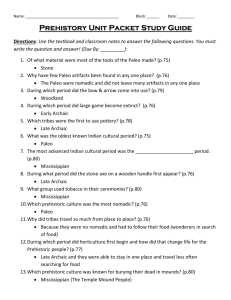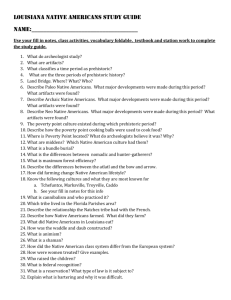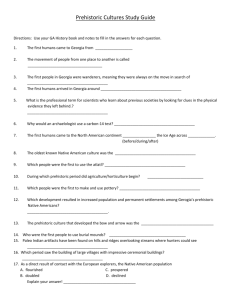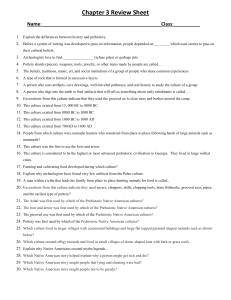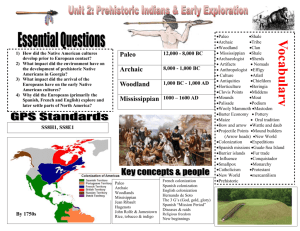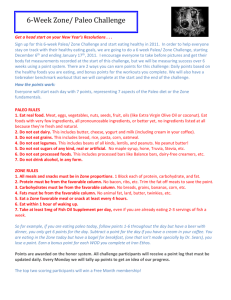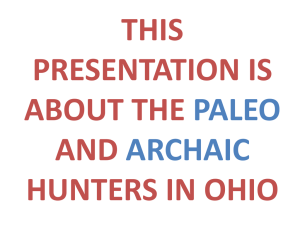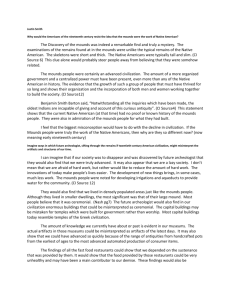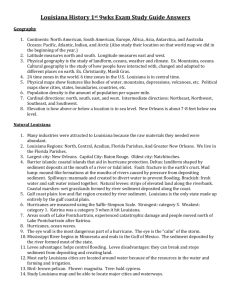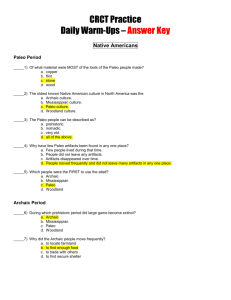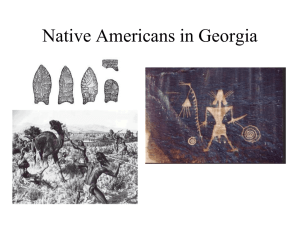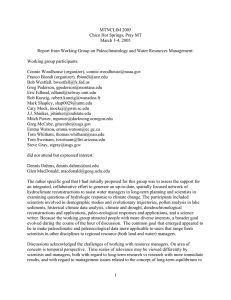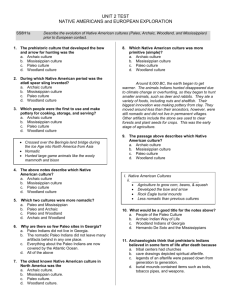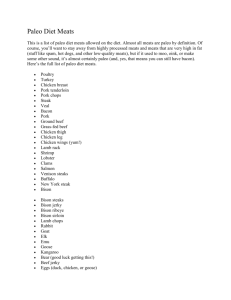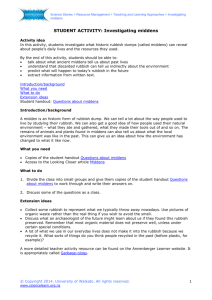Native American study guide Answers
advertisement
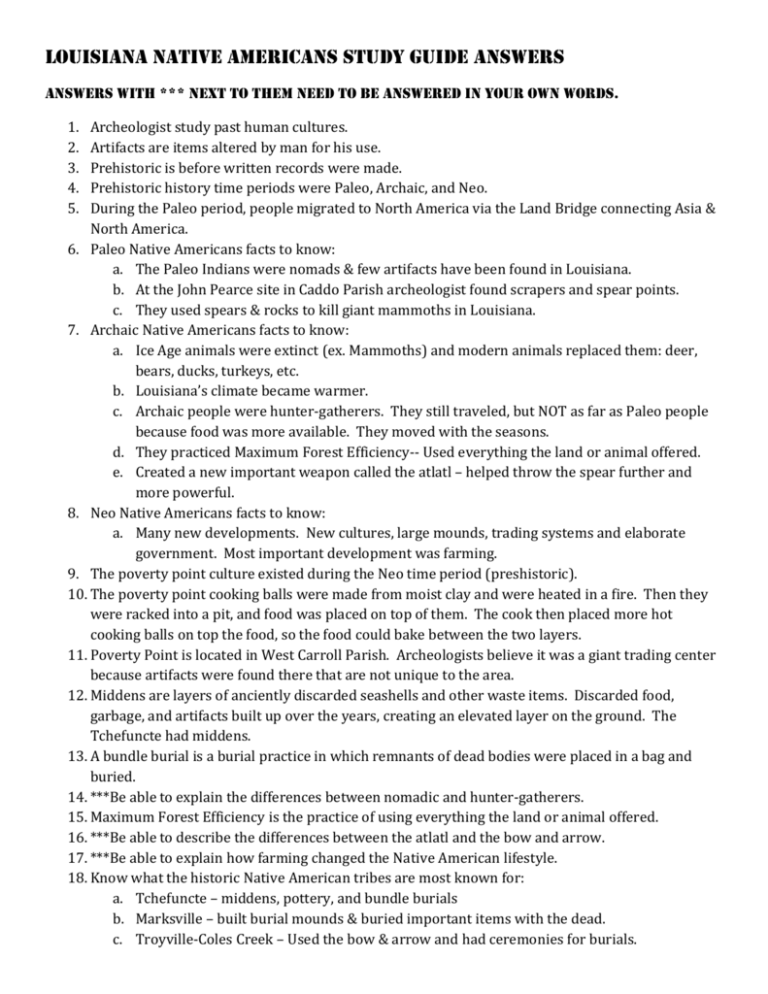
Louisiana Native Americans Study guide answers Answers with *** next to them need to be answered in your own words. 1. 2. 3. 4. 5. Archeologist study past human cultures. Artifacts are items altered by man for his use. Prehistoric is before written records were made. Prehistoric history time periods were Paleo, Archaic, and Neo. During the Paleo period, people migrated to North America via the Land Bridge connecting Asia & North America. 6. Paleo Native Americans facts to know: a. The Paleo Indians were nomads & few artifacts have been found in Louisiana. b. At the John Pearce site in Caddo Parish archeologist found scrapers and spear points. c. They used spears & rocks to kill giant mammoths in Louisiana. 7. Archaic Native Americans facts to know: a. Ice Age animals were extinct (ex. Mammoths) and modern animals replaced them: deer, bears, ducks, turkeys, etc. b. Louisiana’s climate became warmer. c. Archaic people were hunter-gatherers. They still traveled, but NOT as far as Paleo people because food was more available. They moved with the seasons. d. They practiced Maximum Forest Efficiency-- Used everything the land or animal offered. e. Created a new important weapon called the atlatl – helped throw the spear further and more powerful. 8. Neo Native Americans facts to know: a. Many new developments. New cultures, large mounds, trading systems and elaborate government. Most important development was farming. 9. The poverty point culture existed during the Neo time period (preshistoric). 10. The poverty point cooking balls were made from moist clay and were heated in a fire. Then they were racked into a pit, and food was placed on top of them. The cook then placed more hot cooking balls on top the food, so the food could bake between the two layers. 11. Poverty Point is located in West Carroll Parish. Archeologists believe it was a giant trading center because artifacts were found there that are not unique to the area. 12. Middens are layers of anciently discarded seashells and other waste items. Discarded food, garbage, and artifacts built up over the years, creating an elevated layer on the ground. The Tchefuncte had middens. 13. A bundle burial is a burial practice in which remnants of dead bodies were placed in a bag and buried. 14. ***Be able to explain the differences between nomadic and hunter-gatherers. 15. Maximum Forest Efficiency is the practice of using everything the land or animal offered. 16. ***Be able to describe the differences between the atlatl and the bow and arrow. 17. ***Be able to explain how farming changed the Native American lifestyle. 18. Know what the historic Native American tribes are most known for: a. Tchefuncte – middens, pottery, and bundle burials b. Marksville – built burial mounds & buried important items with the dead. c. Troyville-Coles Creek – Used the bow & arrow and had ceremonies for burials. d. Caddo – middle men in trading with the Europeans 19. The Attakapas were cannibals, which means they ate human flesh. 20. The Muskogean lived in the Florida Parishes area. 21. The Natchez were bitter enemies of the French. They were destroyed by French soldiers and scattered amongst other Indian groups. 22. Indians used a farming method called mound farming. They did not plant straight rows of crops. Instead, they made hundreds of small mounds of dirt and planted all the crops together. They farmed corn, beans, and squash. 23. Native Americans in Louisiana ate soups, breads cakes, dumplings, hominy, and corn dishes. They ate catfish, deer, buffalo, and nuts. 24. Waddle and daub houses were made by placing poles into the ground in the shape of the house. Then vines and cane were woven through the poles. Finally, a mixture of mud, moss, and deer hair were plastered over the woven frame. A palmetto frond roof finished off the house. 25. Animism is the belief that everything (people, animals, trees, water, lightning, etc) has a spirit. 26. Shamans are priest or holy people. 27. In the Native American class system it was relatively easy for Indians to move up to a higher class. This is different from the European system because it was very difficult to move up to a higher class in their system. 28. Women has great power and influence. They also did most of the work. They lived in a matriarchal system, so women usually owned the houses and sometimes the fields and crops. Women had the right to divorce their husbands. 29. Children were usually raised by their mother’s brother, who taught and disciplined them. 30. Federal recognition is when a tribe gains recognition by the federal government. It is a difficult process and they must provide tons of historical evidence. 31. When a tribe is federally recognized they get a reservation. This is land given to the tribe by the federal government. Reservations are governed by federal law NOT state law. 32. *** Explain what is bartering and why it was difficult.
